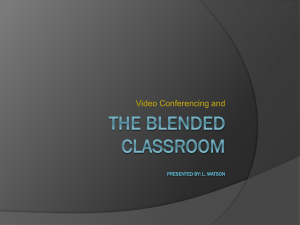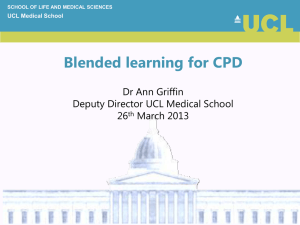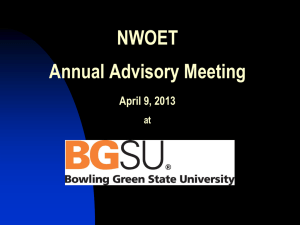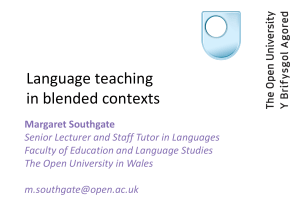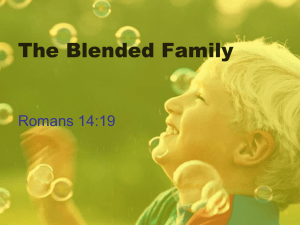symposium on blended learning 5/1/14 powerpoint
advertisement
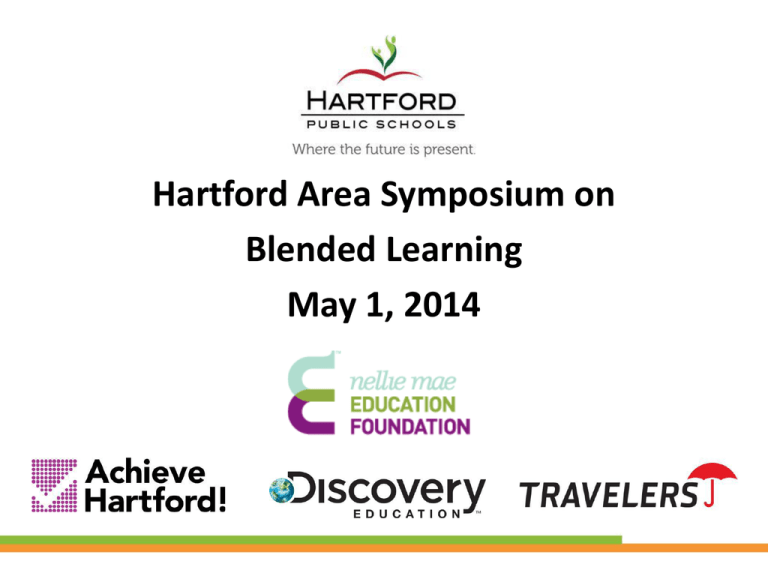
Hartford Area Symposium on Blended Learning May 1, 2014 Welcome and Overview of Evening • Marlene Ibsen, Travelers Foundation • Evening's Agenda 5:00pm: 6:00pm: 6:45pm: 7:50pm 8:00pm Exploring and Piloting Blending Learning in Hartford Public Schools Dinner and Open Lab Opportunity with Discovery Education Roundtable Discussion moderated by Paul Holzer, Achieve Hartford District Participants: Meriden, Manchester, Hartford Public Schools, CT,. Revere in MA Closing Remarks and Next Steps Networking and Cocktail Hour in the Mezzanine 2 Background and Context • Hartford Public Schools Strategic Operating Plan • Student-Centered Frame • Blended Learning – an opportunity for planning and piloting made possible by Nellie Mae Education Foundation Project Goals 1. To increase district and community knowledge of studentcentered blended learning 2. To determine ways to use blended learning to increase student achievement and differentiate learning 3. To engage in action research to pilot and evaluate blended learning approaches in two schools: Pathways Academy of Technology and Design and Bulkeley Teacher Prep and Humanities Academy 4. To share best practices and recommendations from the blended learning research for consideration by the district 4 Phased Planning Allows for Thoughtful Implementation I II III IV V VI Establish Current State: Where we are today Conduct an Innovation Landscape: Explore promising practices Determine Desired State: Develop a Shared Vision for Blended Learning Engage the Community for Input and Expand Knowledge Pilot implementation at Bulkeley and Pathways High Schools Project Report 5 Planning Teams and Key Participants • Superintendent’s Work Group on Student-Centered Learning in High School • Bulkeley/Pathways Professional Learning Community (PLC) P a t h w a y s B u l k e l e y 6 What We Have Done so far: Understand Today’s Learner http://www.youtube.com/watch?v=Ax5cNlutAys &feature=related What We Have Done so far: Defined Blended Learning Blended Learning – a formal education program in which a student learns in part through online learning, with some element of student control over time, place, path, and/or pace; in part in a supervised brick-and-mortar location away from home. (Clayton Christensen Institute, 2012) 8 Explored Blended Learning Models 9 Developed a Theory of Action If we build the capacity of teachers to develop student-centered, blended learning instruction; cultivate 21st century and selfefficacy skills in students; foster collaboration with parents and the community; and if we provide schools with the conditions necessary for successful implementation, then we will see improved student outcomes, increased district capacity, and strong community engagement. Planned for Classroom Implementation • Teachers developed individual implementation plans • Decided on hardware and software tools • Attended conferences, learning sessions, site visits • Determined initial measures of success: – Survey of students and focus group, grades, NWEA, attendance and observations 11 The Hartford Blended Learning Project’s Website – Please join us in enhancing the education of all of Hartford’s and Connecticut’s students through student-centered learning. Please link to http://blendedlearningct.wordpress.com/ Implementation at Bulkeley • 5 teachers in 8 classrooms • 110 Students • Subjects include: Lit and Comp I, US History, Algebra II, Western Humanities Society & Culture, and Western Humanities Literature • Blended Learning models: Station rotation and Flex •Using Hapara, Odyssey, Edmodo, Compass Learning, Newsela, NoRedInk, and self-created materials 13 14 Implementation at Pathways • 3 teachers in 5 classrooms • 102 Students • Subjects include: English, Social Studies, Spanish • Blended Learning models: Station rotation, lab rotation and flex •Web-based Instructional Tools and Resources •Teachers use Study-Island, 10marks, self-created websites and materials, and a school-wide learning management platform. 17 Online Presence: The Portal Reflecting on the Experience What strategies did you implement this week? Did you implement the strategy for the first time or are you continuing a strategy? If continuing, did you modify the strategy in any way? As you implemented your strategy, what were your teacher actions? What student actions did you observe? What observations or evidence of student engagement did you collect this week? Can you associate these results with a particular factor? Why? What student achievement outcomes did you observe or measure this week? Can you associate these results with a particular factor? Why? What soft-skill development outcomes did you observe or measure with your students this week? Describe the skills you observed. Can you associate these results with a particular factor? Why? What changes have you noticed in your own practice this week? What professional development have you engaged in this week? What overall improvements or challenges have you observed in your classes? What student/parent/colleague reactions have you observed? What notes, reflections, or other insights do you have for next week? 19 Themes From Teacher Reflections 25 Bulkeley Teacher Weekly Reflections: Count of Key Themes 20 15 10 5 0 BHS Reflections: March/April BHS Reflections: January/February 20 Themes From Teacher Reflections Pathways Teacher Weekly Reflections: Count of Key Themes 20 18 16 14 12 10 8 6 4 2 Path Reflections: March/April Path Reflections: January/February 0 21 Reflections from Teachers In terms of changes to my own practice, I am working to be less controlling of the class, specifically allowing students to ask and answer each other’s questions without automatically answering myself; allowing students to fully engage in discourse without my interruption. Shayna Chomko, Social Studies Teacher Massive amount of education software available – finding the software with the right fit, level of rigor, alignment to standards and high engagement factor is a difficult task 22 Final Comments • Importance of a vision and open mindset • Research and planning pave the way – Policy, family support and involvement, community partners, facility and operational needs, IT infrastructure, professional development, curriculum and instruction, budget and finance • Q and A 23


